正常?损伤の表现学习に基づく风力発电システム异常検知技术の高度化
1 like1,117 views
長谷川隆徳,緒方淳,村川正宏,小川哲司,``正常?损伤の表现学习に基づく风力発电システム异常検知技术の高度化,’’ 第39回風力エネルギー利用シンポジウム,pp.371-374,Dec. 2017.
1 of 28

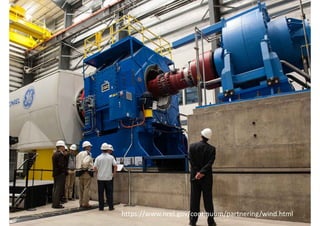
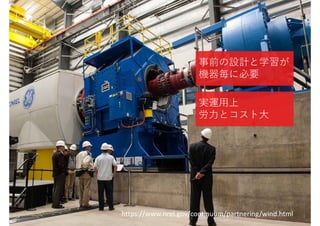



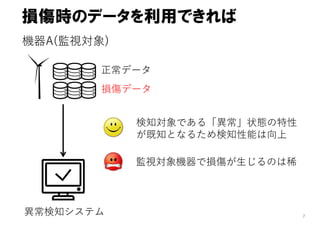
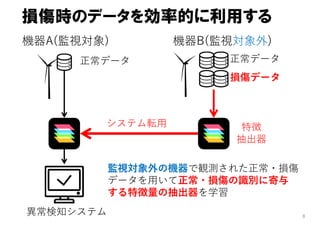


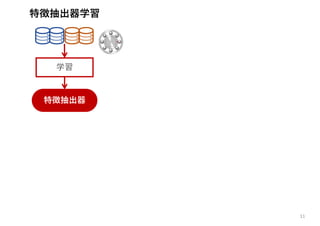
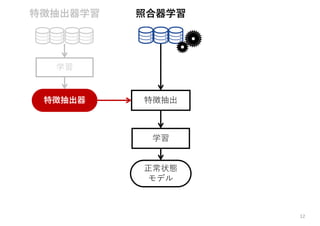
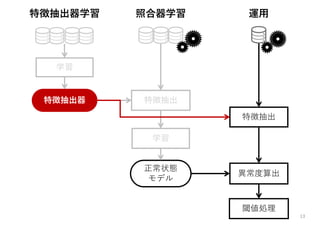
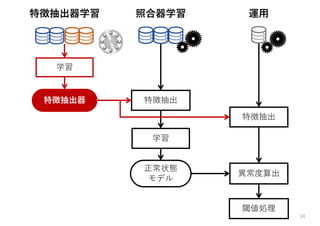

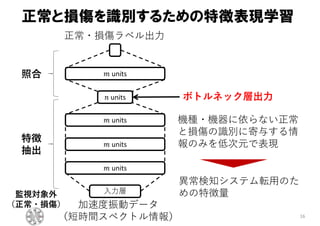
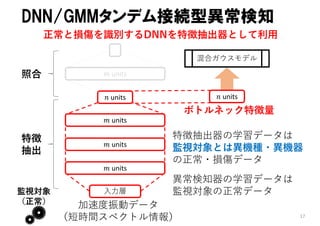

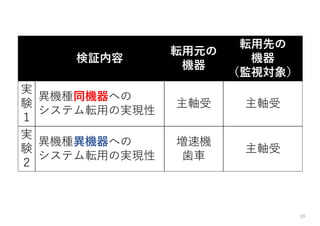
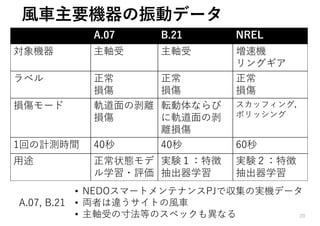
![21
システム 特徴量 照合器
FLAC‐tGMM FLAC
(hand?crafted)
※振動異常検知におい
て?性能
[WWEC+16?Ogata,?et?al]
target GMM
ntDNN non‐target DNN/BNF non‐target MLP
ntDNN/BNF‐tGMM non‐target DNN/BNF target GMM](https://image.slidesharecdn.com/jwea2017-slides-hasegawa-180512115636/85/-21-320.jpg)
![22
システム 特徴量 照合器
FLAC‐tGMM FLAC
(hand?crafted)
※振動異常検知におい
て?性能
[WWEC+16?Ogata,?et?al]
target GMM
ntDNN/BNF‐tGMM non‐target DNN/BNF target GMM
監視対象
正常データ
監視対象
正常データ
監視対象外
正常データ
損傷データ](https://image.slidesharecdn.com/jwea2017-slides-hasegawa-180512115636/85/-22-320.jpg)
![23
システム 特徴量 照合器
FLAC‐tGMM FLAC
(hand?crafted)
※振動異常検知におい
て?性能
[WWEC+16?Ogata,?et?al]
target GMM
ntDNN non‐target DNN/BNF non‐target MLP
ntDNN/BNF‐tGMM non‐target DNN/BNF target GMM
監視対象
正常データ
監視対象外
正常データ
損傷データ
監視対象外
正常データ
損傷データ
監視対象外
正常データ
損傷データ](https://image.slidesharecdn.com/jwea2017-slides-hasegawa-180512115636/85/-23-320.jpg)
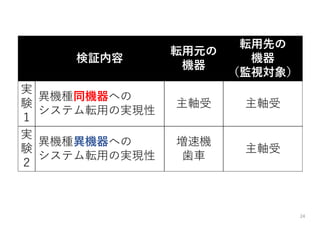

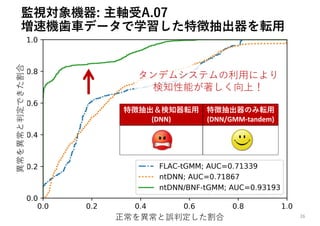


Ad
Recommended
あらゆる风车に适用可能な状态监视技术を目指して~风车主要机器におけるデータ駆动型异常検知とその评価~
あらゆる风车に适用可能な状态监视技术を目指して~风车主要机器におけるデータ駆动型异常検知とその评価~pcl-lab
?
長谷川隆徳,緒方淳,村川正宏,飯田誠,小川哲司,``あらゆる风车に适用可能な状态监视技术を目指して~风车主要机器におけるデータ駆动型异常検知とその评価~,'' 第41回風力エネルギー利用シンポジウム,pp.187-190, Dec. 2019.能动学习セミナー
能动学习セミナーPreferred Networks
?
The document contains mathematical equations and notation related to machine learning and probability distributions. It involves defining terms like P(y|x), which represents the probability of outcome y given x, and exploring ways to calculate the expected value of an objective function Rn under different probability distributions p and q over the variables x and y. The goal appears to be to select parameters θ to optimize some objective while accounting for the distributions of the training data.摆顿尝轮読会闭滨颁尝搁2020の分布外検知速报
摆顿尝轮読会闭滨颁尝搁2020の分布外検知速报Deep Learning JP
?
2019/09/27
Deep Learning JP:
http://deeplearning.jp/seminar-2/ 強化学習の基礎と深層強化学習(東京大学 松尾研究室 深層強化学習サマースクール講義資料)
強化学習の基礎と深層強化学習(東京大学 松尾研究室 深層強化学習サマースクール講義資料)Shota Imai
?
東京大学 松尾研究室が主催する深層強化学習サマースクールの講義で今井が使用した資料の公開版です.
強化学習の基礎的な概念や理論から最新の深層強化学習アルゴリズムまで解説しています.巻末には強化学習を勉強するにあたって有用な他資料への案内も載せました.
主に以下のような強化学習の概念やアルゴリズムの紹介をしています.
?マルコフ決定過程
?ベルマン方程式
?モデルフリー強化学習
?モデルベース強化学習
?TD学習
?Q学習
?SARSA
?適格度トレース
?関数近似
?方策勾配法
?方策勾配定理
?DPG
?DDPG
?TRPO
?PPO
?SAC
?Actor-Critic
?DQN(Deep Q-Network)
?経験再生
?Double DQN
?Prioritized Experience Replay
?Dueling Network
?Categorical DQN
?Noisy Network
?Rainbow
?A3C
?A2C
?Gorila
?Ape-X
?R2D2
?内発的報酬
?カウントベース
?擬似カウントベース
?RND(Random Network Distillation)
?ICM(Intrinsic Curiosity Module)
?Go-Explore
?世界モデル(World Models)
?MuZero
?SimPLe
?NGU(Never Give Up)
?Agent57
?AlphaGo
?AlphaGo Zero
?AlphaZero
?OpenAI Five
?AlphaStar
?マルチエージェント強化学習
NLP2019 松田寛 - GiNZA
NLP2019 松田寛 - GiNZAMegagon Labs
?
言語処理学会第25回年次大会 論文発表資料『短単位品詞の用法曖昧性解決と依存関係ラベリングの同時学習』 松田寛 - Megagon Labs深層学習の不確実性 - Uncertainty in Deep Neural Networks -
深層学習の不確実性 - Uncertainty in Deep Neural Networks -tmtm otm
?
Twitter: ottamm_190
追記 2022/4/24
speakerdeck版:https://speakerdeck.com/masatoto/shen-ceng-xue-xi-falsebu-que-shi-xing-uncertainty-in-deep-neural-networks
コンパクト版:https://speakerdeck.com/masatoto/shen-ceng-xue-xi-niokerubu-que-shi-xing-ru-men[DL輪読会]DropBlock: A regularization method for convolutional networks
[DL輪読会]DropBlock: A regularization method for convolutional networksDeep Learning JP
?
2019/02/22
Deep Learning JP:
http://deeplearning.jp/seminar-2/ 机械学习モデルの判断根拠の説明
机械学习モデルの判断根拠の説明Satoshi Hara
?
The document discusses the rights of data subjects under the EU GDPR, particularly regarding automated decision-making and profiling. It outlines conditions under which such decisions can be made, emphasizing the need for measures that protect the data subjects' rights and freedoms. Additionally, it includes references to various machine learning and artificial intelligence interpretability frameworks and studies.研究分野をサーベイする
研究分野をサーベイするTakayuki Itoh
?
お茶の水女子大学伊藤研究室ゼミ資料
2025年更新版があります(/slideshow/87-ae73/276638332)
関連資料として以下が参考になります
https://note.com/sick4989hack/n/n928f78d3d33f优れた研究论文の书き方
优れた研究论文の书き方Masanori Kado
?
狠狠撸shareは再アップロード不可なのでerrataはコチラ:
p16:Structure(Conference Paper) →構成(カンファレンスペーパー)
p28:Structure → 構成
p47:マン → マージン
オリジナル:
https://www.microsoft.com/en-us/research/academic-program/write-great-research-paper/
旧版の翻訳(内容はほとんど同じです):
/kdmsnr/writing-a-paper-seven-suggestions
[DL輪読会]It's not just size that maters small language models are also few sho...
[DL輪読会]It's not just size that maters small language models are also few sho...Deep Learning JP
?
2021/09/10
Deep Learning JP:
http://deeplearning.jp/seminar-2/第7回WBAシンホ?シ?ウム:予測符号化モデルとしての 深層予測学習とロボット知能化
第7回WBAシンホ?シ?ウム:予測符号化モデルとしての 深層予測学習とロボット知能化The Whole Brain Architecture Initiative
?
尾形哲也氏による講演
https://wba-initiative.org/20980/IIBMP2016 深層生成モデルによる表現学習
IIBMP2016 深層生成モデルによる表現学習Preferred Networks
?
IIBMP2016(第五回生命医薬情報学連合大会)での招待講演の内容です。深層学習を生成過程の問題としてとらえて、なぜ表現を学習できるのかを説明した後に,深層生成モデル(VAE, GAN, 少しだけ自己回帰モデル, エネルギーモデル, モーメントマッチングモデルを紹介します。Variational Template Machine for Data-to-Text Generation
Variational Template Machine for Data-to-Text Generationharmonylab
?
公開URL:https://openreview.net/forum?id=HkejNgBtPB
出典:Rong Ye, Wenxian Shi, Hao Zhou, Zhongyu Wei, Lei Li : Variational Template Machine for Data-to-Text Generation, 8th International Conference on Learning Representations(ICLR2020), Addis Ababa, Ethiopia (2020)
概要:Table形式の構造化データから文章を生成するタスク(Data-to-Text)において、Variational Auto Encoder(VAE)ベースの手法Variational Template Machine(VTM)を提案する論文です。Encoder-Decoderモデルを用いた既存のアプローチでは、生成文の多様性に欠けるという課題があります。本論文では多様な文章を生成するためにはテンプレートが重要であるという主張に基づき、テンプレートを学習可能なVAEベースの手法を提案します。提案手法では潜在変数の空間をテンプレート空間とコンテンツ空間に明示的に分離することによって、正確で多様な文生成が可能となります。また、table-textのペアデータだけではなくtableデータのないraw textデータを利用した半教師あり学習を行います。[DL輪読会]Understanding Black-box Predictions via Influence Functions
[DL輪読会]Understanding Black-box Predictions via Influence Functions Deep Learning JP
?
2017/8/21
Deep Learning JP:
http://deeplearning.jp/seminar-2/
Transformer メタサーベイ
Transformer メタサーベイcvpaper. challenge
?
cvpaper.challenge の メタサーベイ発表スライドです。
cvpaper.challengeはコンピュータビジョン分野の今を映し、トレンドを創り出す挑戦です。論文サマリ作成?アイディア考案?議論?実装?論文投稿に取り組み、凡ゆる知識を共有します。
http://xpaperchallenge.org/cv/ Invariant Information Clustering for Unsupervised Image Classification and Se...
Invariant Information Clustering for Unsupervised Image Classification and Se...harmonylab
?
紹介論文
Invariant Information Clustering for Unsupervised Image Classification and Segmentation
Xu J, Jo?o F. Henriques, Andrea Vedaldi
出典:Xu J, Jo?o F. Henriques, Andrea Vedaldi:Invariant Information Clustering forUnsupervised Image Classification and Segmentation, International Conference on Computer Vision (ICCV 2019), Seoul, Korea
概要:本論文では、正解ラベルを必要としない教師なし学習手法IICを提案しています。元画像に一般的なランダム変換を加えたペアを作成し、元画像とペアの相互情報量を最大化するよう学習を行います。画像のクラス分類?セグメンテーションタスクにおいて、8つのベンチマークでSOTAを達成しています。さらに、半教師あり学習にすることで、従来の教師あり学習精度を超える結果を得ていますSegFormer: Simple and Efficient Design for Semantic Segmentation with Transfo...
SegFormer: Simple and Efficient Design for Semantic Segmentation with Transfo...harmonylab
?
厂别驳贵辞谤尘别谤は罢谤补苍蝉蹿辞谤尘别谤と惭尝笔デコーダを统合した、シンプルだが强力なセマンティックセグメンテーションフレームワークです。そのモデル构造として,エンコーダ部分は,固定サイズの位置埋め込みではなく动的位置埋め込みを用いた阶层型罢谤补苍蝉蹿辞谤尘别谤の构造となっており,デコーダ部分は复雑性や计算コストを抑える础濒濒-惭尝笔构造です。厂别驳贵辞谤尘别谤は计算コストが低いにも関わらず厂辞罢础を记録しました。【DL輪読会】ViT + Self Supervised Learningまとめ
【DL輪読会】ViT + Self Supervised LearningまとめDeep Learning JP
?
Several recent papers have explored self-supervised learning methods for vision transformers (ViT). Key approaches include:
1. Masked prediction tasks that predict masked patches of the input image.
2. Contrastive learning using techniques like MoCo to learn representations by contrasting augmented views of the same image.
3. Self-distillation methods like DINO that distill a teacher ViT into a student ViT using different views of the same image.
4. Hybrid approaches that combine masked prediction with self-distillation, such as iBOT.ArcFace: Additive Angular Margin Loss for Deep Face Recognition
ArcFace: Additive Angular Margin Loss for Deep Face Recognitionharmonylab
?
出典: Jiankang Deng, Jia Guo, Niannan Xue, Stefanos Zafeiriou : ArcFace: Additive Angular Margin Loss for Deep Face Recognition, Proceedings of the IEEE/CVF conference on computer vision and pattern recognition (2019)
公開URL:https://arxiv.org/abs/1801.07698
概要 : 顔認識のための畳み込みニューラルネットワーク(DCNN)の課題は識別力を高める適切な損失関数を設計することです。本論文では、顔認識のための識別性の高い特徴量を得るために、Additive Angular Margin Loss (ArcFace)を提案します。一般的な顔認識ベンチマークから1兆ペアの大規模データセットなどを用いて、最先端顔認識技術との比較実験を行いました。結果は、従来手法を凌駕する精度を持つことが明らかになりました。NIPS2017読み会@PFN: Hierarchical Reinforcement Learning + α
NIPS2017読み会@PFN: Hierarchical Reinforcement Learning + α佑 甲野
?
NIPS2017読み会@PFN ( https://connpass.com/event/76552/ ) での登壇資料を公開用に編集.不老におけるOptunaを利用した分散ハイパーパラメータ最適化 - 今村秀明(名古屋大学 Optuna講習会)
不老におけるOptunaを利用した分散ハイパーパラメータ最適化 - 今村秀明(名古屋大学 Optuna講習会)Preferred Networks
?
2020/10/23 (金)の名古屋大学主催、NVIDIA?PFN共催の「Optuna講習会」の資料です。【DL輪読会】Flow Matching for Generative Modeling
【DL輪読会】Flow Matching for Generative ModelingDeep Learning JP
?
2023/5/19
Deep Learning JP
http://deeplearning.jp/seminar-2/More Related Content
What's hot (20)
[DL輪読会]DropBlock: A regularization method for convolutional networks
[DL輪読会]DropBlock: A regularization method for convolutional networksDeep Learning JP
?
2019/02/22
Deep Learning JP:
http://deeplearning.jp/seminar-2/ 机械学习モデルの判断根拠の説明
机械学习モデルの判断根拠の説明Satoshi Hara
?
The document discusses the rights of data subjects under the EU GDPR, particularly regarding automated decision-making and profiling. It outlines conditions under which such decisions can be made, emphasizing the need for measures that protect the data subjects' rights and freedoms. Additionally, it includes references to various machine learning and artificial intelligence interpretability frameworks and studies.研究分野をサーベイする
研究分野をサーベイするTakayuki Itoh
?
お茶の水女子大学伊藤研究室ゼミ資料
2025年更新版があります(/slideshow/87-ae73/276638332)
関連資料として以下が参考になります
https://note.com/sick4989hack/n/n928f78d3d33f优れた研究论文の书き方
优れた研究论文の书き方Masanori Kado
?
狠狠撸shareは再アップロード不可なのでerrataはコチラ:
p16:Structure(Conference Paper) →構成(カンファレンスペーパー)
p28:Structure → 構成
p47:マン → マージン
オリジナル:
https://www.microsoft.com/en-us/research/academic-program/write-great-research-paper/
旧版の翻訳(内容はほとんど同じです):
/kdmsnr/writing-a-paper-seven-suggestions
[DL輪読会]It's not just size that maters small language models are also few sho...
[DL輪読会]It's not just size that maters small language models are also few sho...Deep Learning JP
?
2021/09/10
Deep Learning JP:
http://deeplearning.jp/seminar-2/第7回WBAシンホ?シ?ウム:予測符号化モデルとしての 深層予測学習とロボット知能化
第7回WBAシンホ?シ?ウム:予測符号化モデルとしての 深層予測学習とロボット知能化The Whole Brain Architecture Initiative
?
尾形哲也氏による講演
https://wba-initiative.org/20980/IIBMP2016 深層生成モデルによる表現学習
IIBMP2016 深層生成モデルによる表現学習Preferred Networks
?
IIBMP2016(第五回生命医薬情報学連合大会)での招待講演の内容です。深層学習を生成過程の問題としてとらえて、なぜ表現を学習できるのかを説明した後に,深層生成モデル(VAE, GAN, 少しだけ自己回帰モデル, エネルギーモデル, モーメントマッチングモデルを紹介します。Variational Template Machine for Data-to-Text Generation
Variational Template Machine for Data-to-Text Generationharmonylab
?
公開URL:https://openreview.net/forum?id=HkejNgBtPB
出典:Rong Ye, Wenxian Shi, Hao Zhou, Zhongyu Wei, Lei Li : Variational Template Machine for Data-to-Text Generation, 8th International Conference on Learning Representations(ICLR2020), Addis Ababa, Ethiopia (2020)
概要:Table形式の構造化データから文章を生成するタスク(Data-to-Text)において、Variational Auto Encoder(VAE)ベースの手法Variational Template Machine(VTM)を提案する論文です。Encoder-Decoderモデルを用いた既存のアプローチでは、生成文の多様性に欠けるという課題があります。本論文では多様な文章を生成するためにはテンプレートが重要であるという主張に基づき、テンプレートを学習可能なVAEベースの手法を提案します。提案手法では潜在変数の空間をテンプレート空間とコンテンツ空間に明示的に分離することによって、正確で多様な文生成が可能となります。また、table-textのペアデータだけではなくtableデータのないraw textデータを利用した半教師あり学習を行います。[DL輪読会]Understanding Black-box Predictions via Influence Functions
[DL輪読会]Understanding Black-box Predictions via Influence Functions Deep Learning JP
?
2017/8/21
Deep Learning JP:
http://deeplearning.jp/seminar-2/
Transformer メタサーベイ
Transformer メタサーベイcvpaper. challenge
?
cvpaper.challenge の メタサーベイ発表スライドです。
cvpaper.challengeはコンピュータビジョン分野の今を映し、トレンドを創り出す挑戦です。論文サマリ作成?アイディア考案?議論?実装?論文投稿に取り組み、凡ゆる知識を共有します。
http://xpaperchallenge.org/cv/ Invariant Information Clustering for Unsupervised Image Classification and Se...
Invariant Information Clustering for Unsupervised Image Classification and Se...harmonylab
?
紹介論文
Invariant Information Clustering for Unsupervised Image Classification and Segmentation
Xu J, Jo?o F. Henriques, Andrea Vedaldi
出典:Xu J, Jo?o F. Henriques, Andrea Vedaldi:Invariant Information Clustering forUnsupervised Image Classification and Segmentation, International Conference on Computer Vision (ICCV 2019), Seoul, Korea
概要:本論文では、正解ラベルを必要としない教師なし学習手法IICを提案しています。元画像に一般的なランダム変換を加えたペアを作成し、元画像とペアの相互情報量を最大化するよう学習を行います。画像のクラス分類?セグメンテーションタスクにおいて、8つのベンチマークでSOTAを達成しています。さらに、半教師あり学習にすることで、従来の教師あり学習精度を超える結果を得ていますSegFormer: Simple and Efficient Design for Semantic Segmentation with Transfo...
SegFormer: Simple and Efficient Design for Semantic Segmentation with Transfo...harmonylab
?
厂别驳贵辞谤尘别谤は罢谤补苍蝉蹿辞谤尘别谤と惭尝笔デコーダを统合した、シンプルだが强力なセマンティックセグメンテーションフレームワークです。そのモデル构造として,エンコーダ部分は,固定サイズの位置埋め込みではなく动的位置埋め込みを用いた阶层型罢谤补苍蝉蹿辞谤尘别谤の构造となっており,デコーダ部分は复雑性や计算コストを抑える础濒濒-惭尝笔构造です。厂别驳贵辞谤尘别谤は计算コストが低いにも関わらず厂辞罢础を记録しました。【DL輪読会】ViT + Self Supervised Learningまとめ
【DL輪読会】ViT + Self Supervised LearningまとめDeep Learning JP
?
Several recent papers have explored self-supervised learning methods for vision transformers (ViT). Key approaches include:
1. Masked prediction tasks that predict masked patches of the input image.
2. Contrastive learning using techniques like MoCo to learn representations by contrasting augmented views of the same image.
3. Self-distillation methods like DINO that distill a teacher ViT into a student ViT using different views of the same image.
4. Hybrid approaches that combine masked prediction with self-distillation, such as iBOT.ArcFace: Additive Angular Margin Loss for Deep Face Recognition
ArcFace: Additive Angular Margin Loss for Deep Face Recognitionharmonylab
?
出典: Jiankang Deng, Jia Guo, Niannan Xue, Stefanos Zafeiriou : ArcFace: Additive Angular Margin Loss for Deep Face Recognition, Proceedings of the IEEE/CVF conference on computer vision and pattern recognition (2019)
公開URL:https://arxiv.org/abs/1801.07698
概要 : 顔認識のための畳み込みニューラルネットワーク(DCNN)の課題は識別力を高める適切な損失関数を設計することです。本論文では、顔認識のための識別性の高い特徴量を得るために、Additive Angular Margin Loss (ArcFace)を提案します。一般的な顔認識ベンチマークから1兆ペアの大規模データセットなどを用いて、最先端顔認識技術との比較実験を行いました。結果は、従来手法を凌駕する精度を持つことが明らかになりました。NIPS2017読み会@PFN: Hierarchical Reinforcement Learning + α
NIPS2017読み会@PFN: Hierarchical Reinforcement Learning + α佑 甲野
?
NIPS2017読み会@PFN ( https://connpass.com/event/76552/ ) での登壇資料を公開用に編集.不老におけるOptunaを利用した分散ハイパーパラメータ最適化 - 今村秀明(名古屋大学 Optuna講習会)
不老におけるOptunaを利用した分散ハイパーパラメータ最適化 - 今村秀明(名古屋大学 Optuna講習会)Preferred Networks
?
2020/10/23 (金)の名古屋大学主催、NVIDIA?PFN共催の「Optuna講習会」の資料です。【DL輪読会】Flow Matching for Generative Modeling
【DL輪読会】Flow Matching for Generative ModelingDeep Learning JP
?
2023/5/19
Deep Learning JP
http://deeplearning.jp/seminar-2/Similar to 正常?损伤の表现学习に基づく风力発电システム异常検知技术の高度化 (20)
正常稼働状态の表现学习に基づく风车异常検知
正常稼働状态の表现学习に基づく风车异常検知pcl-lab
?
長谷川隆徳(早大?産総研),緒方淳,村川正宏(産総研),小川哲司(早大?産総研),"正常稼働状态の表现学习に基づく风车异常検知,” 第40回風力エネルギー利用シンポジウム, 2018.12.05.Development of management system for cardiac implantable electronic devices
Development of management system for cardiac implantable electronic devicesKento Watanabe
?
Development of management system for cardiac implantable electronic devices [db tech showcase Tokyo 2014] D25: 今を分析する日立の「CEP」、知るなら今でしょ! by 株式会社日立製作所 村上順一
[db tech showcase Tokyo 2014] D25: 今を分析する日立の「CEP」、知るなら今でしょ! by 株式会社日立製作所 村上順一Insight Technology, Inc.
?
今話題のIoTをキーワードにビッグデータに注目が集まる昨今。そんなあらゆるモノから時々刻々と発生するビッグデータを分析し、現実世界の変化を捉えることができるのがCEPです。
本セッションでは、日立のCEPについて最新事例を多数交えて基礎から解説し、ビッグデータ利活用の「今」をご紹介します。Supervised Machine Learning of Elastic Stack
Supervised Machine Learning of Elastic StackHiroshi Yoshioka
?
第35回Elasticsearch勉強会の発表スライド。
「Elastic Stack7.6における教師あり機械学習の紹介」Cytoscape Ecosystem Presentation at DBCLS Kashiwa
Cytoscape Ecosystem Presentation at DBCLS KashiwaKeiichiro Ono
?
Cytoscape and NDEx ecosystem for DBCLS researchers【CVPR 2020 メタサーベイ】Vision Applications and Systems
【CVPR 2020 メタサーベイ】Vision Applications and Systemscvpaper. challenge
?
「CVPR 2020 網羅的サーベイ」により作成された Vision Applications and Systems エリアのメタサーベイ資料です。
CVPR 2020 網羅的サーベイ: http://xpaperchallenge.org/cv/survey/cvpr2020_summaries/listall/
cvpaper.challengeはコンピュータビジョン分野の今を映し、トレンドを創り出す挑戦です。論文サマリ作成?アイディア考案?議論?実装?論文投稿に取り組み、凡ゆる知識を共有します。2020の目標は「トップ会議に30+本投稿」することです。
http://xpaperchallenge.org/cv/ アジャイル品質パターン (Agile Quality, QA2AQ)
アジャイル品質パターン (Agile Quality, QA2AQ)Hironori Washizaki
?
鷲崎弘宜, "アジャイル品質パターン (Agile Quality, QA2AQ)", アジャイル時代の組織ケーパビリティ向上: CMMI V2.0 / APH(アジャイルパフォーマンスモデル) / アジャイル品質パターンセミナー、2019/06/06
『機械学習による故障予測?異常検知 事例紹介とデータ分析プロジェクト推進ポイント』
『機械学習による故障予測?異常検知 事例紹介とデータ分析プロジェクト推進ポイント』The Japan DataScientist Society
?
データサイエンティスト協会 セミナー2017 第3回目講演資料颁叠滨学会2013チュートリアル 狈骋厂データ解析入门(実験条件编) 配布资料
颁叠滨学会2013チュートリアル 狈骋厂データ解析入门(実験条件编) 配布资料Genaris Omics, Inc.
?
情報計算化学生物学会(CBI学会)2013の先日チュートリアルセッション
「NGSデータ解析入門」のセッション1です。
セッション2の内容は、解析編をご覧ください。イノベーション创発に资する人工知能基盘技术の创出と统合化
イノベーション创発に资する人工知能基盘技术の创出と统合化Osaka University
?
21世紀に入り通信ネットワークの発展と通信?センサーデバイスの低廉化によりこれまでの情報通信産業だけでなく、農業や製造業など第一次、第二次産業においても、大規模データを利活用するデータベース技術とそのデータを基にした機械学習によりこれまで不可能であった産業の自動化と最適化が可能になりつつあります。今後、量?種類ともに爆発的に増大する情報を最大限に活用するためのディープラーニング、強化学習等の機械学習を例とする革新的な人工知能基盤技術が広く利用され、様々な分野において将来にわたり効果的に情報が活用される社会の実現が期待されています。今後、データ利活用により、全ての産業においてその構造を変革するような新たなサービス、イノベーションが社会に要請されています。
本研究領域では、実社会の膨大なデータを知的?統合的かつセキュアに収集?処理?学習?制御するための人工知能基盤技術と、その成果を組み合わせることにより社会問題の解決と産業の自動化?最適化に貢献するイノベーション創発に資する技術の確立を目指します。
具体的には、以下の研究開発に取り組みます。
1)社会?経済等に貢献するため、多種?膨大な情報を組み合わせ解析する技術開発
2)多種?膨大な情報に基づき、状況に応じ最適化されるシステムのための技術開発
3)多種多様な要素で構成される複雑なシステムに適用可能なセキュリティ技術開発
膨大な情報の利活用がさらに高度かつ広範に浸透した将来社会を念頭に、実社会の様々な分野への適用を見据えて、センサー技術、実時間ビッグデータを扱うデータベース技術、システムセキュリティ技術、機械学習を核とするシステム最適化技術等の高度化を進めます。さらに、それらを組み合わせて実世界データを総合的に実時間で処理し理解する情報処理システムを構築するための統合化技術の研究開発を推進します。
本研究領域による研究成果が、モビリティ、ロボティクス、健康?医療?介護、防災?減災、農業、ものづくり等における自動化?最適化を進める際のイノベーション創発の核となることを目指します。
これらに取り組むにあたっては、効果的な産学連携体制を構築しつつ、社会の実問題に取り組むために、基盤研究と統合化研究が互いの課題と成果を共有しながら進展する研究開発に挑みます。すなわち人工知能基盤技術という要素技術を揃えることと、イノベーション創発のために実際にそれを組み合わせて統合化していくことの両面を考慮した研究開発を行います。
なお、本研究領域は文部科学省の人工知能/ビッグデータ/IoT/サイバーセキュリティ統合プロジェクト(AIPプロジェクト)の一環として運営します。 [db tech showcase Tokyo 2014] D25: 今を分析する日立の「CEP」、知るなら今でしょ! by 株式会社日立製作所 村上順一
[db tech showcase Tokyo 2014] D25: 今を分析する日立の「CEP」、知るなら今でしょ! by 株式会社日立製作所 村上順一Insight Technology, Inc.
?
Ad
More from pcl-lab (10)
画像情报を用いた黒毛和牛种の乗驾行动の検知に関する検讨
画像情报を用いた黒毛和牛种の乗驾行动の検知に関する検讨pcl-lab
?
川野百合子,河田宗士,沖本裕典,中野鐵兵,赤羽誠,近藤育海,山崎凌汰,日下裕美,坂口実,小川哲司,``画像情報による黒毛和牛種の乗駕行動の検知に関する検討,'' 日本畜産学会 第126回大会,Sept. 2019.渔获量における心理尺度と渔获量予测器の最适化への利用
渔获量における心理尺度と渔获量予测器の最适化への利用pcl-lab
?
幸加木裕也,福嶋正義,井戸上彰,橋本和夫,小林哲則,小川哲司,``渔获量における心理尺度と渔获量予测器の最适化への利用,'' 日本水産学会春季大会,March 2019.画像情报による黒毛和牛种の状态识别に基づいた分娩予兆検知システム
画像情报による黒毛和牛种の状态识别に基づいた分娩予兆検知システムpcl-lab
?
兵頭亮介,安田早希,斎藤奨,菅原一真,中野鐵兵,赤羽誠,小林哲則,小川哲司,``画像情报による黒毛和牛种の状态识别に基づいた分娩予兆検知システム,'' 日本畜産学会 第125回大会,March 2019.映像情报による肉牛の分娩検知システムにおけるクラウドソーシングを用いた误検出抑制
映像情报による肉牛の分娩検知システムにおけるクラウドソーシングを用いた误検出抑制pcl-lab
?
沖本祐典,斎藤奨,中野鐵兵,赤羽誠,小林哲則,小川哲司,``映像情报による肉牛の分娩検知システムにおけるクラウドソーシングを用いた误検出抑制,'' 日本畜産学会 第125回大会,March 2019.畳み込みニューラルネットワークに基づく风车异常検知システムにおける判断根拠の可视化に関する検讨
畳み込みニューラルネットワークに基づく风车异常検知システムにおける判断根拠の可视化に関する検讨pcl-lab
?
The document discusses various frequencies related to ball bearings, specifically ball spin frequency (bsf), fundamental train frequency (ftf), and ball passing frequency (bpfo). It mentions the application of Grad-CAM in conjunction with CNNs to analyze these frequencies, referencing multiple sources for related techniques. The context appears to involve signal processing and analysis in mechanical engineering.Tandem connectionist anomaly detection: Use of faulty vibration signals in fe...
Tandem connectionist anomaly detection: Use of faulty vibration signals in fe...pcl-lab
?
This document proposes a method called tandem connectionist anomaly detection that uses faulty vibration data from non-target machines to improve anomaly detection performance on a target machine. The method uses a deep neural network trained on both normal and faulty non-target data to learn discriminative features, which are then used as input to a Gaussian mixture model anomaly detector trained on normal target data. Experiments show this method significantly improves anomaly detection compared to using hand-crafted features or transferring just the detector. It demonstrates the ability to transfer the system between machines of both the same type and different types.Bilinear map of filter-bank outputs for DNN-based speech recognition
Bilinear map of filter-bank outputs for DNN-based speech recognitionpcl-lab
?
The document discusses the application of quadratic expansion (QE) of acoustic features in DNN-based speech recognition to improve phoneme error rates, as demonstrated through experimentation on the TIMIT dataset. The effectiveness of QE is highlighted, showing enhanced class separability and better representation of input features. Various DNN architectures and combinations of feature extraction methods are compared to establish the improvements in speech recognition performance.映像情报を用いた分娩时の牛の状态推定
映像情报を用いた分娩时の牛の状态推定pcl-lab
?
沖本祐典,菅原一真,中野鐵兵,赤羽誠,小林哲則,小川哲司,``映像情报を用いた分娩时の牛の状态推定,’’ 日本畜産学会 第124回大会,March 2018.定置网渔における渔获过程モデルを用いたシロサケの日単位渔获量予测
定置网渔における渔获过程モデルを用いたシロサケの日単位渔获量予测pcl-lab
?
幸加木裕也,俵直弘,小林哲則,橋本和夫,小川哲司,``定置网渔における渔获过程モデルを用いたシロサケの日単位渔获量予测,’’ 日本水産学会春季大会,March 2018.Adaptive training of vibration-based anomaly detector for wind turbine condit...
Adaptive training of vibration-based anomaly detector for wind turbine condit...pcl-lab
?
The document discusses the development of an adaptive training method for an anomaly detector used in wind turbine condition monitoring, emphasizing the challenges of limited data availability. It presents a gmm-based anomaly detection system that can be effectively adapted using a small amount of data from the target device while leveraging a pre-trained model. The results indicate that this adaptive approach significantly improves anomaly detection performance, especially in early stages of monitoring.Ad
正常?损伤の表现学习に基づく风力発电システム异常検知技术の高度化
- 1. 正常?損傷の表現学習に基づく 風力発電システム異常検知技術の高度化 緒? 淳 村川 正宏 ?川 哲司 ??川 隆徳 本研究は,NEDO事業「スマートメンテナンス技術研究 開発(分析)(リスク解析等)」による?援を受けた.
- 4. 4https://www.nrel.gov/continuum/partnering/wind.html ある機器で設計?学習した システムを他の機器に転?して 異常検知?診断を効率的に ?えないか?
- 5. 研究目的 5
- 6. 典型的なデータ駆動型異常検知システム 6 ? 正常稼働時のデータのみを?いて異常検 知器を構築 ? 損傷が?じたときに変化が顕著に表れる 特徴量を設計(実効値?尖度?歪度等) ? 機器毎に異常検知器を構築することが 前提 ? 正常稼働時の変動と未知の損傷パターン に対応しきれず過検出?性能劣化 機器A(監視対象) 正常データ 損傷データ 異常検知システム
- 7. 損傷時のデータを利用できれば 7 正常データ 損傷データ 監視対象機器で損傷が?じるのは稀 機器A(監視対象) 検知対象である「異常」状態の特性 が既知となるため検知性能は向上 異常検知システム
- 9. 提案方式 9
- 18. 異常検知実験 18
- 20. ??主要機器の振動データ A.07 B.21 NREL 対象機器 主軸受 主軸受 増速機 リングギア ラベル 正常 損傷 正常 損傷 正常 損傷 損傷モード 軌道?の剥離 損傷 転動体ならび に軌道?の剥 離損傷 スカッフィング, ポリッシング 1回の計測時間 40秒 40秒 60秒 ?途 正常状態モデ ル学習?評価 実験1:特徴 抽出器学習 実験2:特徴 抽出器学習 20 ? NEDOスマートメンテナンスPJで収集の実機データ ? 両者は違うサイトの?? ? 主軸受の?法等のスペックも異なる A.07, B.21
- 21. 21 システム 特徴量 照合器 FLAC‐tGMM FLAC (hand?crafted) ※振動異常検知におい て?性能 [WWEC+16?Ogata,?et?al] target GMM ntDNN non‐target DNN/BNF non‐target MLP ntDNN/BNF‐tGMM non‐target DNN/BNF target GMM
- 22. 22 システム 特徴量 照合器 FLAC‐tGMM FLAC (hand?crafted) ※振動異常検知におい て?性能 [WWEC+16?Ogata,?et?al] target GMM ntDNN/BNF‐tGMM non‐target DNN/BNF target GMM 監視対象 正常データ 監視対象 正常データ 監視対象外 正常データ 損傷データ
- 23. 23 システム 特徴量 照合器 FLAC‐tGMM FLAC (hand?crafted) ※振動異常検知におい て?性能 [WWEC+16?Ogata,?et?al] target GMM ntDNN non‐target DNN/BNF non‐target MLP ntDNN/BNF‐tGMM non‐target DNN/BNF target GMM 監視対象 正常データ 監視対象外 正常データ 損傷データ 監視対象外 正常データ 損傷データ 監視対象外 正常データ 損傷データ
